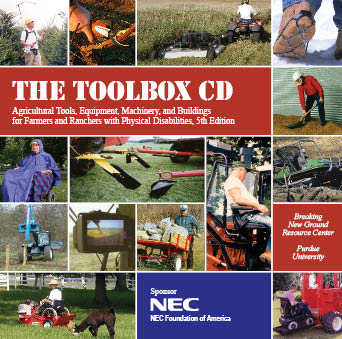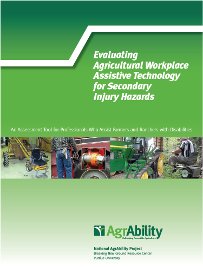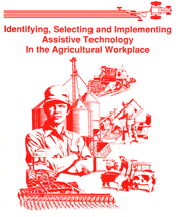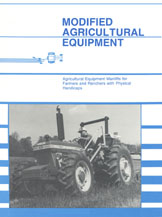Assistive Technology
Assistive technology (AT) is defined as any item, piece of equipment, or product system, whether acquired commercially, modified, or customized, that is used to increase, maintain, or improve functional capabilities of individuals with disabilities. (Assistive Technology Act of 1998). For agricultural workers with disabilities, many solutions exist, including manufactured devices or structures, modified work practices, and do-it-yourself plans. The National AgrAbility Project provides many resources for identifying, locating, obtaining, and fabricating AT.
The TOOLBOX: Agricultural Tools, Equipment, Machinery, and Buildings for Farmers and Ranchers with Physical  Disabilities
Disabilities
The TOOLBOX contains both commercially available products and homegrown ideas from agricultural producers themselves. Solutions cover a wide range of categories, including tractors and self-propelled equipment, crop and materials handling, shops and shop tools, livestock handling and housing, and outdoor mobility.
The online version of The TOOLBOX contains the most recently updated and current information for rural assistive technology that is available. The print and CD versions of The TOOLBOX are also available. Contact us to order a copy.
Visit the online version of The TOOLBOX.
Assistive Technology Catalogue Directory
To assist visitors to the AgrAbility website in becoming more familiar with catalogs as problem solving tools, a description of several catalogs, some that might be unfamiliar to many, and examples of products they contain that have potential application to persons with disabilities are being provided. Hopefully, some of these resources will provide a few “Ah Ha” moments and avoid the need to reinvent the wheel. View the Catalog Online
Evaluating Agricultural Workplace Assistive Technology for Secondary Injury Hazards

This assessment tool is designed to identify possible injury risks associated with assistive technologies (ATs) used—and often fabricated—by farmers and ranchers with disabilities so that those risks can be eliminated or at least minimized.
The resource’s five sections include: an introduction to the tool, its purpose, and component worksheets; steps in carrying out the assessment process; explanation (with pictures) of 55 identified potential injury-causing items; example of a completed assessment done on a specific AT; and a set of copier-ready blank worksheets.
The assessment tool is intended as a follow-up companion to the Breaking New Ground publication, Conducting Agricultural Worksite Assessments: A User’s Guide for Professionals Assisting Farmers and Ranchers with Physical Disabilities.
- Evaluating Agricultural Workplace Assistive Technology for Secondary Injury Hazards [PDF]
- Conducting Agricultural Worksite Assessments [PDF]
Alternative Financing Programs for Assistive Technology
Alternative Financing Programs (AFPs) provide low-interest cash loans for the purchase of assistive technology devices and services. AFPs can also provide information about other possible funding resources. AFPs are flexible programs and can help finance utility vehicles, adapted farm equipment, home modifications, etc. Alternative Financing Programs used to be associated with the archaic term “tech act project,” and now falls under three distinct categories: State AT Projects, Alternative Financing Programs, Protection and Advocacy organizations (now called the Disability Rights Network). For additional details and contact information, contact the Association of Assistive Technology Act Programs (ATAP) (the technical assistance provider for AFPs).
Assistive Technology Needs Assessment of Farmers and Ranchers with Spinal Cord Injuries (1992)
This manual reports findings of a study completed by BNG, funded by the Paralyzed Veterans of America Spinal Cord Research Foundation in which farmers and ranchers with spinal cord injuries were surveyed to determine rehabilitation technology needs. Click here for a PDF copy.
Identifying, Selecting, and Implementing Assistive Technology in the Agricultural Workplace

Provides assistance to rural rehabilitation professionals and other service providers in identifying, selecting and using assistive technology that is appropriate for the agricultural workplace. Chapters address several topics, including what is assistive technology, how to select the appropriate level of accommodation, developing creative solutions to agricultural workplace barriers and strategies for financing assistive technology. Click here for a PDF copy.
Modified Agricultural Equipment: Manlifts for Farmers & Ranchers with Physical Handicaps

This 322-page manual contains descriptions and evaluations of 27 modified, self-propelled agricultural machines. Modifications include chair, platform, wheelchair platform, and sling lifts. Each summary gives information on adaptability and compatibility of the lift, maintenance requirements, description of operation and cost estimates. Click here for a PDF copy.
Technical Articles
The Plowshares are technical articles that were published by the Breaking New Ground Resource Center over several years. Each report focuses on a specific topic on farming/ranching with a disability.
Links
- Rehabilitation Engineering and Assistive Technology Society of North America (RESNA) is a professional society for individuals and organizations interested in technology and disability